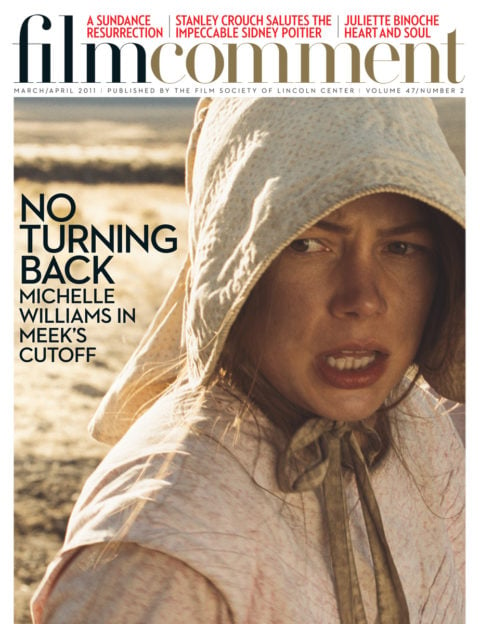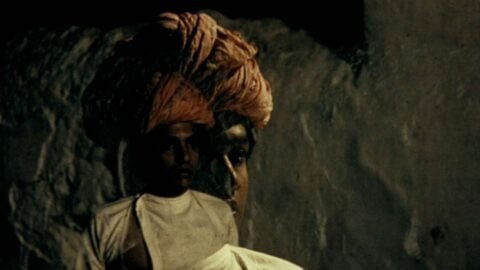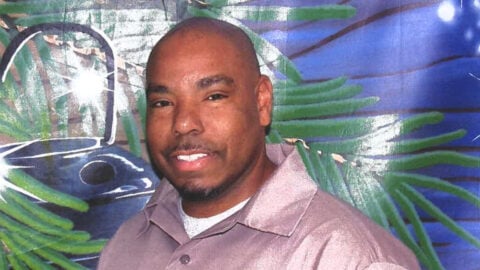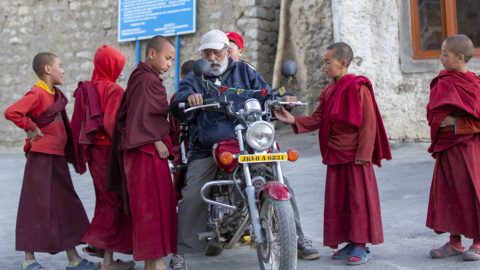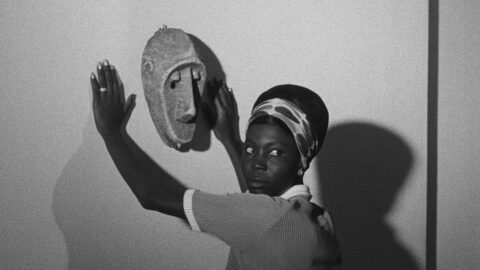
What’s in a name? When it comes to identifying a group of highly auspicious films made by a collective of prodigiously talented generational contemporaries, it can mean the difference between wider recognition from the critical/festival/distribution establishment and consignment to obscurity. (To wit, how many mumblecore films have seen the light of day thanks to the coinage of that term?) So far, relative anonymity has been the lot of Serge Bozon and a half-dozen other young French cinéastes who, between 1997 and 2005, contributed to the film journal La Lettre du cinéma, and who have since gone on to create a series of films as highly original and formally innovative as any of the more celebrated “new” national cinemas (Argentina, Romania, South Korea) that have dominated the conversation over the last decade.
This is France, however, where the term “New Wave” carries a particularly sacrosanct connotation, and the existence of a strong national industry and international distribution channels leads many to believe that, surely, any films of note will somehow, eventually find their way into the world. Yet in the case of Bozon and the other Lettre du cinéma filmmakers, edgy, cinephile festivals like Belfort, Buenos Aires, Rotterdam, and Vienna have been their primary refuge, with little to no commercial distribution anywhere in the world, not even, in a few cases, in France—a “New Wave” without a name nor, it would seem, much of an audience.
Of course, any such attempt to classify a group is, at best, a generalization that risks reducing a robust variety of new and distinctive voices to a convenient shorthand. In the early Eighties, the pop-saturated films of Luc Besson, Leos Carax, and Jean-Jacques Beineix were christened (by critic Raphaël Bassan) the cinéma du look—a movement that, like the cultural trends that influenced it, was destined to go out of fashion after a few seasons. Writing a decade later in The New York Times, Phillip Lopate wondered if a term like “new New Wave, the Next Wave or the Re-New Wave” should be applied to the films then first turning up on American screens by the likes of Olivier Assayas, Arnaud Desplechin, Gaspar Noé, and Bruno Dumont, and perhaps those filmmakers are lucky that one of those labels—and the accompanying weight of expectation—never stuck.
In the case of Bozon and company, however, the “New Wave” analogy is arguably more apt, not only because they are a group of cinephile critics turned filmmakers, but because their work has been produced and distributed completely outside of the French studio system, under the auspices of a few maverick producers (in particular David Thion and Philippe Martin of the company Les Films Pelléas), and in at least one case (Jean-Charles Fitoussi’s 2008 magnum opus Je ne suis pas morte) entirely self-financed.
If the 36-year-old Bozon is not entirely unknown in cinephile circles, it is thanks to his third feature, La France, which premiered in the 2007 Directors Fortnight in Cannes, traveled quite widely on the international festival circuit and, although never acquired for U.S. distribution, did receive a series of bookings as part of a North American tour organized by the programmers of Seattle’s Northwest Film Forum. La France was also, with a French box-office haul of just over $100,000, easily the most widely seen of the Lettre du cinéma films to date (if still a “disappointment” relative to the film’s 1.8 million euro budget). It’s also easy to think of Bozon as the central figure in the Lettre movement, thanks in part to his frequent (and fine) work as an actor in the films of his peers.

La France
An unclassifiable hybrid of war movie and musical, La France tells the story of a WWI soldier’s wife (Sylvie Testud) who disguises herself as a man and sets off for the front in search of her husband. Along the way, she meets up with a company of soldiers under the command of a gruff lieutenant (Pascal Greggory) who reluctantly allows this strange young man to join their ranks. Only late in the film do we learn that the soldiers and the lieutenant are themselves in the process of deserting. Periodically, and with no advance warning, the men break out a series of crude homemade instruments and perform original songs co-written for the film by Benjamin Esdraffo (Bozon’s assistant director) and the artist known as Fugu, styled after the American “sunshine pop” of groups like the Beach Boys and the Mamas and the Papas, and the British “popsike” (aka psychedelic pop) of the Move and the Flower Pot Men. (Music is central to the work of Bozon, who also maintains a sideline as a DJ, and whose 2002 feature, Mods, squeezes a treasure trove of Sixties garage rock into 60 minutes of screen time, including songs by Phil and the Frantics, the Calico Wall, and the Unrelated Segments.)
If La France feels like the logical starting point for a discussion of Bozon and his contemporaries, it’s because it is also something of a group portrait. The screenplay is by former Lettre du cinéma editor-in-chief Axelle Ropert (who also wrote Mods, and also directed the medium-length Étoile violette and the 2009 feature The Wolberg Family, as well as appearing multiple times as an actress in the films of Bozon et al.). The supporting cast includes Lettre du cinéma contributors Esdraffo—who directed the 45-minute Clarisse’s Neck (03)—and the Russian-born Pierre Léon (the director of four features), and actors Laurent Lacotte and Guillaume Verdier (both of whom appear in multiple films of Bozon, Léon, Ropert and fellow Lettre alums Sandrine Rinaldi and Jean-Paul Civeyrac). The cinematographer responsible for La France’s dreamlike eternal twilight—evoking the day-for-night shooting of classic Hollywood war movies and Westerns—is none other than Bozon’s sister, Céline, whose résumé also includes films by nearly every filmmaker mentioned thus far.
As in any truly vital artistic movement, the critic-filmmakers of La Lettre du cinéma are as distinct from one another in style and approach as, say, Matisse from Picasso, or Truffaut from Godard—and yet, viewed collectively, their films appear to be in conversation with each other, to orbit the same universe. To speak of these connections in terms of content, there is, first and foremost, a Rohmerian preoccupation with literature and philosophy. In Mods, we learn that a university student, who has fallen into a kind of lovesick coma, is envied by his classmates for his voracious reading ability, while Étoile violette (05) concerns a tailor (Bozon) who, seeking enlightenment, enrolls in a night-school lit class and ends up communing with the sprit of Jean-Jacques Rousseau himself (played by Lou Castel). Léon’s L’Adolescent (01) and L’Idiot (08) are both Dostoyevsky adaptations, the first done in color and modern dress, the second in black and white and set in an unspecified period. Rinaldi’s Mystification ou l’histoire des portraits (03) is based on an unpublished Diderot text about a man (played by Bozon) trying to destroy the evidence of a past affair. The central character in Civeyrac’s Man’s Gentle Love (02) is inspired by the Belle époque writer and libertine Jean de Tinan. Aurélia Georges’s The Walking Man (07) is a biography of sorts of the Russian-Jewish writer Vladimir Slepian. Even in La France, when the soldiers are not singing, they sit around the campfire reading a fictitious book about Atlantis, scripted by Ropert in the style of Jules Verne.

The Day I Don’t Exist
Compounding this connection with the literary past, there is often the feeling of characters existing outside of normal space and time—literally, in the case of the protagonist in Fitoussi’s marvelous debut, The Days I Don’t Exist (02), who experiences life only every other day, vanishing into thin air at the stroke of midnight only to reappear in the same location 24 hours later, or the eponymous spirits that haunt Civeyrac’s third feature, Fantômes (01), dearly departed souls who nightly regain human form and visit their loved ones, whom it becomes increasingly difficult to tell apart from the ghosts. And touches of the fantastic abound in Man’s Gentle Love, set in a parallel reality where people are mysteriously disappearing en masse from the streets of Paris, and in Fitoussi’s Je ne suis pas morte, in which a woman is brought into existence at the age of 27 by a descendant of Dr. Frankenstein, perfectly human save for her inability to fall in love. Of the latter film, which runs 190 minutes, I would like to say much more, but I have seen it only once, at the 2008 Viennale, and it has yet to receive a release, in theaters or on video, anywhere in the world, making re-viewing impossible. My recollection is that it is close to a masterpiece.
If Bozon, Ropert, and Fitoussi all bring varying degrees of whimsy to their work, Civeyrac could be considered the group’s tragic romanticist and Pierre Léon its brooding old Russian soul. All, if it isn’t already obvious, are devoted to narrative modes of storytelling in a way that runs counter to the verité fact/fiction hybrids and ethnographic minimalism that have become the dominant enthusiasms of international film festivals in recent years. And yet we are somehow still on the surface of these works, which are perhaps most striking for the uncommon sincerity and lack of postmodern snark with which they address such eternal dramatic questions as the nature of valor (Bozon), the possibility of true love (Fitoussi), and the existence of virtue in a corrupt society (Léon).
In formal terms, there is another comparison to be made to Rohmer, given the preponderance of talk, real Paris locations, fixed sequence shots, and full-frame aspect ratios. (It should also be noted that nearly all of these films have been shot on film as opposed to video, some in 35mm and others in 16mm.) Reviewing the somewhat more elaborate (given its higher budget) La France for Variety from Cannes, I found myself dubbing it “Bresson meets the Beatles”—the kind of reductive, yet not entirely inaccurate, catchphrase conceived in the heat of daily deadlines. In fact, the encyclopedic list of influences Bozon has cited for the film range from such obvious precursors as Raoul Walsh’s Objective Burma! (particularly for its lighting) and Sam Fuller’s Merrill’s Marauders to Russian director Boris Barnet’s obscure A Good Lad (for its operatic musical sequences) and Jean-Pierre Jeunet’s saccharine A Very Long Engagement (the movie Bozon, writing in a recent issue of the French film journal Vertigo, says La France was designed to critique, the way Rio Bravo was a critique of High Noon).
Not surprisingly, Bozon has acknowledged a close, if not exact, correlation between the tastes of La Lettre du cinéma and those of le cercle du MacMahon, the group of passionate young cinephiles whose programming at Paris’s MacMahon cinema in the Fifties introduced French audiences to the work of Walsh, Lang, Preminger, Losey, and many more. But the axis of filmmakers that exerts the most direct influence on Bozon and company is another group of largely overlooked French directors, a generation and a half older than the Lettre du cinéma gang, known informally by the name of the production company that produced many of their films: Paul Vecchiali’s Les Films Diagonale.
A Corsican-born, openly gay author and filmmaker, who recently published a two-volume, 1600-page “ciné encyclopedia” devoted to French filmmakers of the Thirties, Vecchiali has remained little known outside of France (only one of his features, 1979’s Corps à coeur, was distributed in the U.S., under the title Drugstore Romance). But from 1976 until the early Nineties, he became an important producer of work by young filmmakers working well outside the commercial mainstream, including Marie-Claude Treilhou’s Simone Barbes ou la Vertu (80) and the first two features of former Cahiers critic and Trafic co-founder Jean-Claude Biette, Le Théâtre des matières (77) and Loin de Manhattan (82). In addition, Bozon has frequently cited two other filmmakers, Pierre Zucca and the Spanish émigré Adolfo Arrieta, who, while not produced by Diagonale, made films very much in the Diagonale spirit.
Biette (who died in 2003) is a particular touchstone for Léon, who was his friend and student and who has just completed a feature-length documentary about his films and criticism (almost none of which has been translated into English). Bozon, meanwhile, writing in the debut issue of La Lettre du cinéma, described Biette’s cinema as “a bit whimsical, falsely severe and decidedly frisky,” before continuing: “The cinema of Jean-Claude Biette is, for many young people, far away from Franco-French traditionalism, an area of freedom.” Which may be, some decades on from now, how another new generation of French filmmakers will look back on the work of these children of Diagonale.
Flash forward to the fall of 2010. For 10 days in November, Bozon with the help of yet another Lettre alum, Pascale Bodet, commandeer the first floor of the Pompidou Centre with an exhibition entitled Beaubourg, la dernière major!, a revisionist history of a century of French cinema (each day devoted to a successive decade), according to its audacious curators. But this is no monomaniacal affair. Rather, Bozon invites all his friends and collaborators, his mentors and influences, and the result is a veritable three-ring circus of screenings, lectures, dialogues, performances, and more. Raúl Ruiz comes to present a selection of films by the pioneer science filmmaker Jean Painlevé, and takes over the museum’s basement to shoot his own 52-minute film about an aquarium. Vecchiali lectures on Jean Grémillon. Popular French comedy duo Eric and Ramzy present the work of Erich von Stroheim—a filmmaker they had never even heard of before receiving the invitation. Each day begins with Benjamin Esdraffo singing the program of the day and ends with a Bozon DJ set. In between, spectators can watch Bozon, a small crew, and actors Laure Marsac and Thomas Chabrol (son of Claude) shooting a 45-minute film entitled The Impresario on another floor of the museum, from 11 a.m. to 6 p.m. daily.
And with that show, finally, the needle has moved slightly on the Lettre du cinéma visibility meter. Just since January, two major English-language articles have appeared on the subjects of Bozon, La Lettre, and Diagonale. The first, published in the FIPRESCI’s online magazine Undercurrent, is a long interview with Pierre Léon about Biette, with many interesting digressions. The second, published at MUBI, is an equally long interview with Bozon and Bodet about the Beaubourg project. Both were conducted by the Boston-based critics Larysa Smirnova and Dmitry Martov, and are hopefully the first of many more to come. There are other stirrings, too: a French release—finally—in 2011 for Je ne suis pas morte, and the anticipated start of production on a new Bozon feature, Tip Top. But still, no name in sight.



